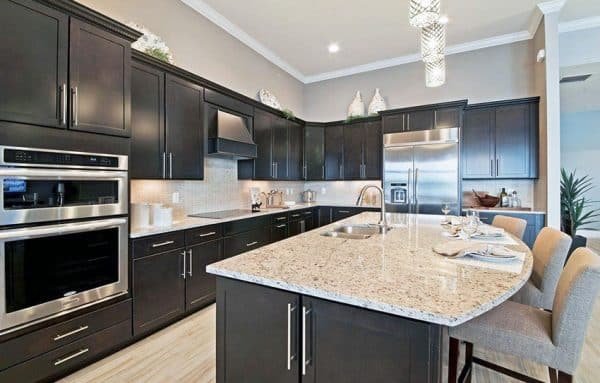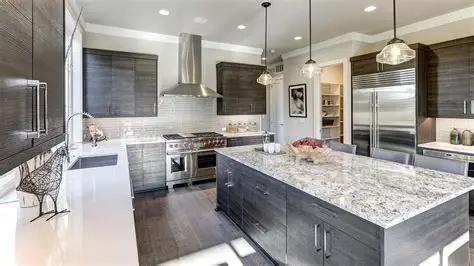
Granite is one of the most admired natural stones in the world—valued for its durability, elegance, and unique mineral makeup.
Granite is one of the most admired natural stones in the world—valued for its durability, elegance, and unique mineral makeup. From ancient temples to modern kitchen countertops, granite’s appeal lies in both its geological origins and its stunning appearance. But what exactly gives granite its remarkable qualities?
In this in-depth guide, we’ll explore what minerals are in granite, how they contribute to its beauty and strength, and how this knowledge can guide your design and material choices.

Understanding Granite: An Overview
What Is Granite?
Granite is a coarse-grained igneous rock formed from the slow crystallization of magma beneath the Earth’s surface. It’s primarily composed of interlocking crystals of quartz, feldspar, and mica, making it both durable and visually distinctive.
Explore more: What is granite made of?

Primary Minerals in Granite
Granite’s composition includes several key minerals, each with unique properties that affect the stone’s appearance and physical characteristics.
1. Quartz
- Color: Clear, white, or gray
- Hardness: 7 on Mohs scale
- Role: Contributes durability and subtle shimmer
- Percentage: Typically 20–40% of granite
Quartz is one of the hardest minerals in granite, offering exceptional scratch resistance, which makes it ideal for countertops.
2. Feldspar
- Types: Orthoclase (pink) and plagioclase (white to gray)
- Color Contribution: Pink, white, and gray hues
- Role: Provides structure and coloration
- Percentage: About 50% of granite’s volume
Feldspar is the dominant mineral in most granite stones and defines the primary tone of the slab.
3. Mica
- Types: Biotite (black) and muscovite (silvery)
- Appearance: Adds sparkle and luster
- Role: Enhances visual contrast and texture
Mica flakes give granite its signature glint under light and offer a hint of elegance to darker granite types.
Accessory Minerals in Granite
Granite may also contain trace minerals that give it unique coloration and texture:
- Amphibole: Greenish-black or dark green flecks
- Magnetite: Adds magnetic properties in rare cases
- Zircon and Garnet: Contribute minor decorative features
These minerals vary based on the geographic origin of the granite, contributing to the diversity of granite types worldwide.
Natural vs. Engineered Granite
While natural granite contains a complex mineral matrix, engineered versions mimic these qualities using resin and aggregates.
| Feature | Natural Granite | Engineered Granite |
|---|---|---|
| Composition | Quartz, feldspar, mica | Crushed stone + resin |
| Appearance | Natural veining | Uniform look |
| Maintenance | Requires sealing | Low maintenance |
Visual Impact: Mineral Influence on Granite Appearance
Color Variety
- White granite countertops: Rich in quartz and white feldspar
- Black granite countertops: Biotite and amphibole dominate
- Pink granite: High in orthoclase feldspar
Texture and Pattern
- Granular texture: Due to interlocking crystals
- Veins and swirls: Caused by mineral flow during formation
Granite Design and Edge Choices
Granite’s mineral makeup also influences how it can be cut and polished for home design.
Common edge styles include bullnose, ogee, and beveled—each complementing the stone’s unique mineral character.
Aardwolf Granite Solutions
Aardwolf offers a complete granite countertop collection, complete with premium slabs and installation services.
Explore tools for professionals:
Popular colors include:
- Aardwolf white granite
- Aardwolf black granite
- Aardwolf exotic granite colors
Granite and Water Absorption
Mineral density affects how granite interacts with moisture:
- Quartz and feldspar: Low absorption
- Mica: Slightly more porous
Granite is typically low-porosity, but surface sealing is essential for long-term stain resistance—especially in kitchen and bathroom environments.
See also: Which layer will become saturated first when rain falls?
Conclusion: Minerals Define Granite’s Strength and Style
Granite is much more than a rock—it’s a natural composite of durable and decorative minerals. The presence of quartz, feldspar, and mica shapes its strength, color, and style, making it a favorite in both design and construction.
From classic white and black countertops to exotic slabs, understanding the minerals in granite helps you choose the perfect stone for your space—and ensures long-lasting performance and visual appeal.

